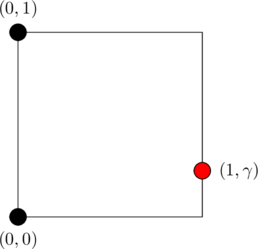The following questions were proposed to me by professor Zvonko Iljazović.
Let ![]() . We define the metric
. We define the metric ![]() be the metric defined as
be the metric defined as
![]()
for all ![]() . Let
. Let ![]() .
.
Let ![]() and
and ![]() . Suppose
. Suppose ![]() is a sequence in
is a sequence in ![]() such that the sequences
such that the sequences ![]() and
and ![]() are computable sequences
are computable sequences ![]() ? Does the sequence
? Does the sequence ![]() need to be computable in the sense that its components are computable sequences
need to be computable in the sense that its components are computable sequences ![]() ?
?

Let ![]() where
where ![]() is an incomputable real. Then
is an incomputable real. Then ![]() however,
however, ![]() is not a computable sequence.
is not a computable sequence.
Now the second question. Let ![]() ,
, ![]() and
and ![]() . Let
. Let ![]() be a sequence such that
be a sequence such that ![]() ,
, ![]() and
and ![]() are computable sequences
are computable sequences ![]() . Does the sequence
. Does the sequence ![]() need to be computable?
need to be computable?
The answer is yes. The proof is available in our upcoming publication "Dense Computability Structures".
Proposition:
The metric space ![]() has at least two maximal computability structures in which points
has at least two maximal computability structures in which points ![]() and
and ![]() are computable.
are computable.
Proof:
Let ![]() be a computable sequence in
be a computable sequence in ![]() such that
such that ![]() . Let
. Let ![]() be a computability structure induced by
be a computability structure induced by ![]() . Since
. Since ![]() is separable, it is also maximal.
is separable, it is also maximal.
Let ![]() where
where ![]() is an incomputable real. Then the finite sequence
is an incomputable real. Then the finite sequence ![]() has the property
has the property ![]() hence by definition
hence by definition ![]() is an effective finite sequence.
is an effective finite sequence.
Therefore,
![]()
is a computability structure and there exists a maximal computability structure ![]() such that
such that ![]() and
and ![]() are computable points in
are computable points in ![]() .
.
On the other hand, the point ![]() is not computable in
is not computable in ![]() since that would contradict the fact that
since that would contradict the fact that ![]() is a non-computable real. This is equivalent to the fact that
is a non-computable real. This is equivalent to the fact that ![]() . Therefore,
. Therefore, ![]() . From this we conclude that
. From this we conclude that ![]() and
and ![]() are two maximal computability structures on
are two maximal computability structures on ![]() in which points
in which points ![]() and
and ![]() are computable.
are computable.